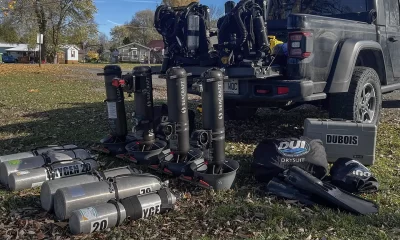Cave
Celebrating Sheck Exley
It’s fair to say that technical diving—specifically cave diving—would not be what it is, nor would we be diving as deep, for as long, or as far, or as safe, as we are today if not for cave explorer, pioneer, and educator Sheck Exley. We celebrate his life and extraordinary achievements in a collection of curated stories beginning with Ned Deloach’s 1988 classic, “THE DEEPEST DIVE: A Study in Controlled Paranoia,” which originally ran in Ocean Realm magazine.
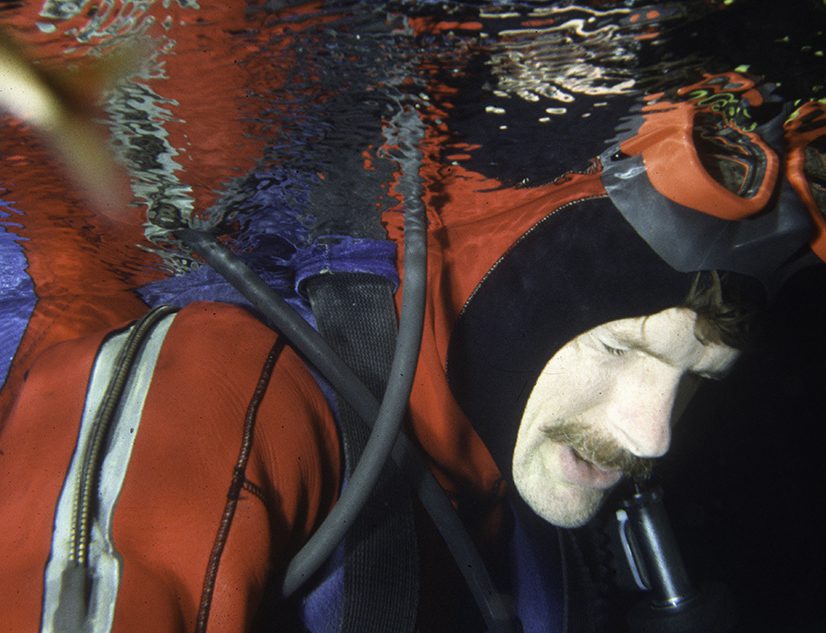
Header photo: In preparation for his arduous dive at Mante, Sheck removed his mask and meditated with his face in the cool water. Photo by Ned Deloach.
Celebrating Sheck Exley: It’s fair to say that technical diving—specifically cave diving—would not be what it is, nor would we be diving as deep, for as long, or as far, or as safe as we are today if not for cave explorer, pioneer and educator Sheck Exley, who was born on April 1, 1949 and died on April 6, 1994. We celebrate his life and extraordinary achievements in this issue of InDepth.
By day, a quiet, soft spoken high school algebra teacher at Suwannee High, in Live Oak, Florida , Sheck Exley was arguably also the world’s greatest cave diver. Certified in scuba at the age of sixteen, Exley became the first person to log a thousand cave dives, accomplishing this feat in less than seven years. Over the nearly three decades that followed, Exley explored and surveyed most of the world’s known deep water cave systems. In the process, he pioneered many of the fundamental methods, techniques, and equipment used in cave diving, invented the redundant second-stage regulator, applied accident analysis to cave diving, and adapted mixed gas technology to open circuit scuba.
Exley repeatedly redefined the limits of self-contained diving, extending those limits ever deeper and longer. Just consider the fact that he was conducting solo cave dives to depths beyond 200 meters/ 653 feet five years before the sport diving industry knew how to spell N-I-T-R-O-X. In 1973, the thoughtful educator turned passionate cave explorer helped to establish the National Speleological Society’s Cave Diving Section (NSS-CDS), served as its first president, and published over 100 articles and six books on the subject of his passion.
On October 29, 1983, Sheck married fellow cave diver Mary Ellen Eckhoff while submerged in Thunderhole Cave System. Henry Nicholson performed the ceremony. Eleven years later Sheck died at the age of 45 while trying to bottom out Zacatón in Northeast Mexico, in collaboration with fellow explorer Jim Bowden. The two were diving on separate descent lines and out of sight of one another so as not to result in a double fatality. Sheck never surfaced. Jim was injured but survived the dive and set a new depth record in the process.
There is an old joke about Exley in Global Underwater Explorer (GUE) circles. It claims that if Sheck had used a team and “standard gases,” there wouldn’t have been a Florida cave left for anyone to explore. That is, of course, with the exception of sidemount caves—Sheck didn’t do sidemount (GUE didn’t either until recently). To this day, cave divers are still finding some of his original exploration lines.
I once asked Sheck during an interview what motivated him to do the dives he did. He paused for a moment before answering, “We can see what’s on the dark side of the moon or what’s on Mars, but you can’t see what’s in the back of a cave unless you go there. And there’s a special feeling when you know no one else has been there before. ”
At the time, Sheck had no way of knowing that more than a quarter century later his friend Bill Stone, who he taught to cave dive, would invent an autonomous cave exploration robot that could find and explore the back of a cave, but his words still ring true. He is speaking to our innate genetic predisposition to explore—to go boldly go where no one has gone before—which arguably, lies at the heart and soul of technical diving, and perhaps diving itself. Surely without that spirit to drive us, humans would never have ventured into underwater caves.
In this issue of InDepth, we offer you a depth full buffet of stories from back in the day about Sheck Exley, beginning with this 1988 classic shown just below, “The Deepest Dive: A Study in Controlled Paranoia,” by Ned Deloach, first published in Ocean Realm magazine. In addition, we’ve included my 1992 aquaCORPS interview with Sheck, “Exley on Mix,” and a personal story Sheck wrote for aquaCORPS about the tragic death of his brother Edward, “It’s Your Call.”
There’s a 1995 article about Sheck’s exploration at Zacatón with Jim Bowden and Dr. Ann Kristovich, “Dr. Ann and the Zacatón Explorers” by Jim Kelly. Included also is the accident report of his death, “What Happened to Sheck Exley?” by Dr. Bill Hamilton, Bowden and Kristovich. We also feature a short film tribute to Sheck, “Birth of A Cave Diving Legend” by cave diver Jim Thomas (see below). The film investigates and recreates a young Sheck’s famous “close call” running out of gas at Peacock Springs and finding a new exit as featured in Sheck’s book, “The Taming of the Slough,” published after his death.
As a special treat, courtesy of the NSS-CDS and the Exley archives, we’ve included a commemorative issue of Underwater Speleology, specifically November /December 1994 issue Underwater Speleology V 21 N6 with Sheck’s writings, that was published six months after his death. Special thanks to Mary Ellen Eckhoff and to filmmaker Brian Udoff, who is making a documentary about Sheck, for supplying the issue and pictures. There’s also a link to three of Sheck’s books at the online NSS-CDS bookstore. There are more surprises.
All of this from the passionate, evidently obsessively compulsive divers at GUE’s InDepth. So pull out your pre-dive checklist and dive right in. We celebrate you Sheck Exley!—Michael Menduno/M2
THE DEEPEST DIVE: A Study in Controlled Paranoia
by Ned Deloach
“THE DEEPEST DIVE” was originally published in Ocean Realm magazine’s Summer 1988 issue
At the sound of the last bell on Friday afternoon, April 1, 1988, Sheck Exley locked the door to his classroom at Suwannee High in Live Oak, Florida, where he teaches algebra. It was the beginning of Spring Break. He signed out, joked briefly with a few students gathered at the school’s entrance, and walked across the parking lot to his red Ford van. The chassis was sitting unusually low. Sheck knelt down to inspect the rear tires. He made a mental note to inflate them even more.
Causing pressure on the tires was the weight of 34 scuba tanks packed carefully inside. Each cylinder was filled to capacity with gas mixtures—helium, oxygen, and compressed air. The sizable collection of tanks, enough to supply the average needs of a sport diver for a lifetime, would be required for Sheck to make a single exploratory dive into Nacimiento Del Rio Mante.

Mante is a water-filled spring cave located in northern Mexico, west from Tampico, across a fertile plain that runs inland from the Gulf of Mexico for 60 miles/97 kilometers. The flat land ends abruptly just past the farming community of Ciudad Mante, where an ancient geological fault split the earth and pushed the continent straight up over 2000 ft/609.6 m. Flowing mysteriously from the mountain’s base is a clear river. The cool water streams from a dark cave entrance, briefly forming a spring pool that quickly narrows and begins to wind its way east across the arid farmland.
The river is a welcomed anomaly where rain is scarce and the tropical sun unrelenting. From the early Native Mexicans until today, the local inhabitants have gathered in the basin’s pleasant surroundings. They wash in the cool, sweet water that is shaded by the cliff above. Tall, flowering trees line the water’s edge. Fragrant blossoms of purple, gold, and white-shower down on the bathers below. Where the river comes from, no one knows. “From the other side of the mountain,” you will be told, with a shrug, if you ask.
Unlike the bathers who relax daily in the spring’s outflow, Sheck knew well the hidden river’s path. He had made four previous dives into the mountain cave starting in 1979, and he was leaving that afternoon to make another.
On his first trip, Sheck and veteran cave diver Paul Deloach penetrated 150 ft/46 m into Mante’s cave opening, where they located the cavern’s true course—a narrow fissure that dropped directly down the great fault.
“We had dived several other Mexican spring caves before we arrived at Mante,” Sheck recalled. “Most began with a steep drop, but would form into a horizontal tunnel at a depth between 140-190 ft/43-58m. Mante was different; it just kept dropping beneath us. Although the crevice was over 100 ft/30m, it was quite narrow, just over 3 ft/1m in places. The current was difficult. Enough water was shooting up the passage to feed a river that runs for miles. Moving against it was like swimming up a waterfall. We used our hands to pull on the sharp rock walls. Both of us were pretty cut up after the dive.” Three hundred and thirty feet (100 m) below the surface the divers stopped, hovering on the very edge of their physical limits. Below, Mante continued its plunge into darkness.
“At our turnaround point I remember thinking about Sotano de los Golondrinas, the world’s deepest free-falling pit that was just 96 km/60 miles south of us. Its drop is 1248 feet/380 m. Could Mante be this deep? It was exciting to think that we might be suspended inside the deepest underwater cave in the world.”
Both divers knew to venture no further. In the deep passage, their minds were already swirling with vertigo that would intensify with depth until reality blurs into unconsciousness. Sheck tied the safety line to a rock projection and began to ascend. The return to the surface would be slow—over an hour. Long, tedious decompression was the price they paid for going deep.
Two of the world’s most experienced deep water cave divers had once again been turned away by the “depth barrier”—a set of physiological hazards that had taunted them for over a decade. These hazards combined to make deep diving a risky business below 130 ft/40 m, and past 300 ft/92 m almost suicidal. It was clear: if Mante’s secrets were to be discovered, technology would have to advance to a point where narcosis could be suppressed and decompression time shortened.
Less than a decade later Sheck would explore far beyond the “barrier” on a dive that would establish Mante as the deepest water cave in the Western Hemisphere and, in doing so, he would set a depth record so extraordinary that it was unimaginable in 1979.
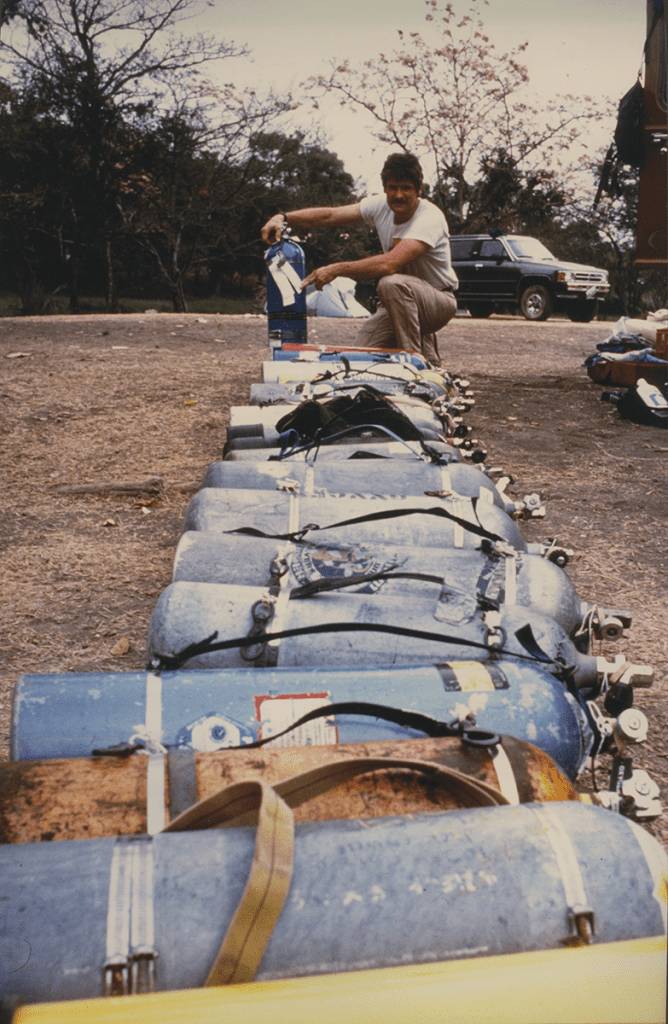
After his reconnaissance trip to north Mexico’s caves, Sheck returned to Florida where he continued to lead the way in the exploration, surveying, and mapping of the state’s extensive aquifer system—an obsession that has directed his life since he became certified in scuba in 1965, at the age of sixteen. He made his first open-water dive in a shallow spring cave in Florida’s Crystal River. Although the limestone opening offered limited penetration, it was enough to ignite an insatiable curiosity that would, in only a few years, propel Sheck to the forefront of underwater exploration. In less than seven years, at the age of 23, he became the first person to log 1000 cave dives. This was an average of two and a half cave dives per week. During the same period he graduated from high school and the University of Georgia in Athens, a 600-mile round trip from the north Florida spring caves. In May 1987, his 3000th cave dive was entered in his log.
Sheck not only leads the way in the caves, but also in cave diving education. An untiring effort has produced over 100 articles and six books on the subject. He has been repeatedly honored for his accomplishments, including being named a Fellow of the National Speleological Society and Explorer’s Club and, in 1981, receiving the Lew Bicking Award as America’s top cave explorer.
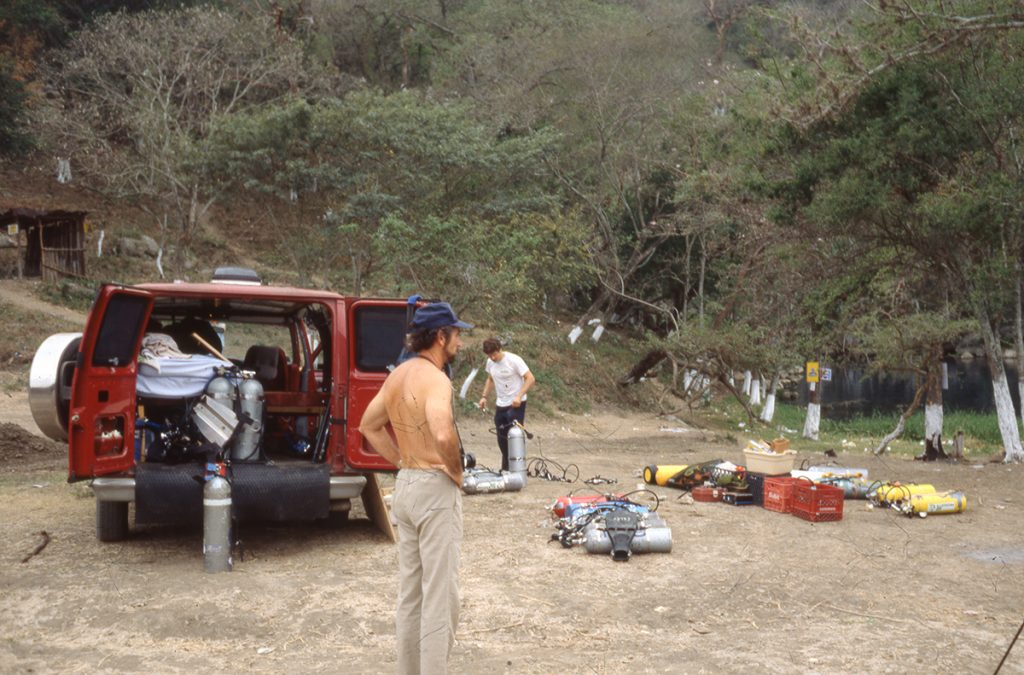
Although Sheck is proud of these honors, they are not a compelling force behind what he does. He is an inherent explorer whose true passion is to go where no one has gone. Our planet’s last unmeasured frontier—the earth’s depths—is the realm he has chosen to enter. This compulsion has, for 23 years, repeatedly driven him further and deeper into water caverns than anyone has gone before. At 39 he remains a forerunner with visions yet to conquer.
“Thirty-nine is old for pushing physiological limits in underwater caves. Marathon runners tell you that your respiratory efficiency, critical on a deep dive, drops enormously as you reach the mid-30s, and the risk of bends rapidly increases with age after 30. I still feel well prepared, mentally and physically, but I am constantly aware of my age. I must always factor it into my dive plans.”
“Nine years ago, when I first dived Mante, I was at a physical peak, but it didn’t matter because we hadn’t yet gained the know-how to go deeper. I remember looking at the cave dropping below us into unattainable depths—it might as well have been a painting. Underwater cave exploration is a technologically dependent endeavor, and we were then locked out by numerous constraints. I had no idea then if I would ever be able to explore Mante further, and even less idea from what direction new technology would come to make it possible.”
As it turned out, it was a combination of three elements—oxygen, helium, and computerized decompression tables incorporating these gasses—that would be the key to new possibilities.
In the early 70s, cave divers took a lead from the US Navy and began to experiment with oxygen. Its use helped to shorten the long decompression stops required after lengthy cave penetrations. Breathing from tanks filled with pure oxygen at the ten and twenty-foot intervals could cut decompression time by as much as half.
Like everything associated with deep diving, however, the innovation was not without risk. It was quickly learned that if too much oxygen was breathed below 33 ft/10 m, a deadly condition called oxygen toxicity (oxygen poisoning) developed. Symptoms are extreme—sudden convulsions, then death. To complicate things ever further, the Navy’s oxygen tables were based on experiments conducted with unexerted subjects locked out in dry chambers. When cave divers applied the Navy’s times to their stressful environment, problems developed. Sheck cared even less for the long decompress periods than most cave divers.
“Five or six hours spent hanging off in the cool water of a spring basin was a numbing conclusion to long and difficult exploratory dives,” he explained. “The sheer boredom was grueling. We used to read, play magnetic checkers, or pull tricks on each other, but generally we would put ourselves into a trance. Oxygen was a great help. It was the closest thing to a decompression pill we found.”
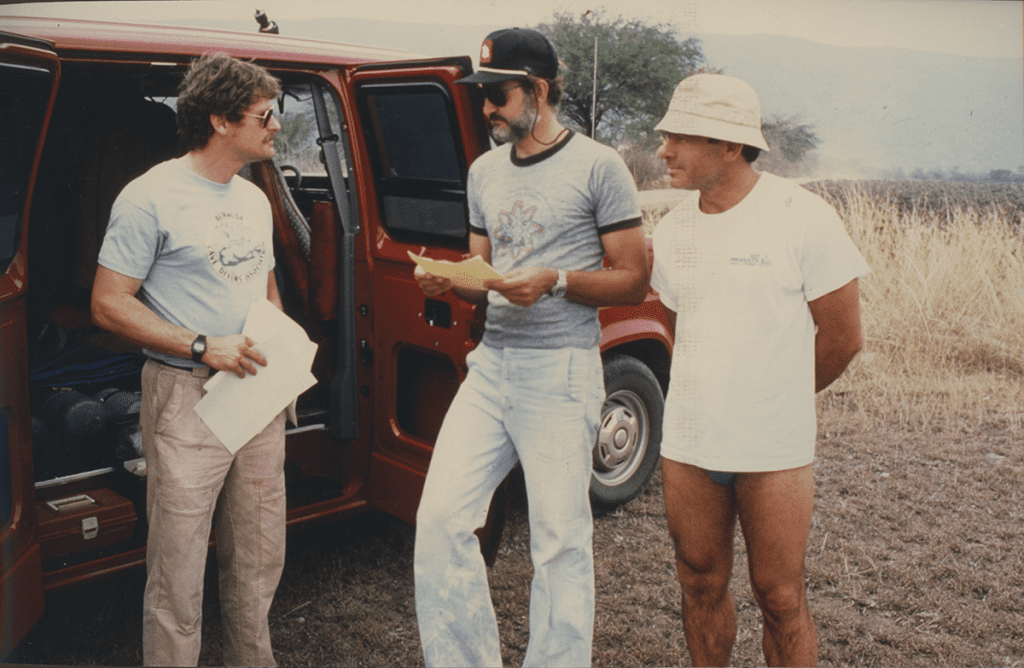
Early experimentation by the Navy found that the substitution of helium for nitrogen in underwater breathing mixtures greatly reduced narcosis. The ability to dive deep and remain clear headed would be a dramatic breakthrough for cave explorers, but problems complicated early trials. The Navy spent a great deal of time trying to devise safe helium tables but were thwarted by the gas’ volatile nature. Decompression times proving safe for one diver would cause severe cases of the bends in others. Helium also caused a rapid reduction of body heat, bringing about hypothermia. On top of these problems, when breathed at great depths, it played havoc with the diver’s nervous system. Sheck doubted that the gas would ever have any serious application in cave exploration. The few divers that did use helium met with mixed results, and often tragedy.
The helium horror stories started in 1970 when Hal Watts, a pioneer deep diver from Orlando, Florida, used a helium mixture during a body recovery at Mystery Sink. The Navy declined to take part in the search but recommended a heliox (helium/oxygen) mixture for the difficult dive. Hal remembers being cold and nervous as he dropped into the lower reaches of the sinkhole. Failing to find the lost diver, he headed toward the surface. During ascent, problems occurred forcing Hal to miss his 60 ft/18 m decompression stop. He sustained a severe bends hit.
“The pain felt like my lower spine had been injected with hot lead. I agonized and vomited constantly for the two and a half hours it took to get me to a chamber at the Cape,” Hal vividly recalled. It was a year before he completely recovered from the painful injury.
Sheck’s closest friend, Lewis Holtzendorff, died in 1975 while attempting the world’s first cave dive using helium. The divers were decompressing on oxygen at 40 ft/12 m after a dive of 265 ft/81 m. Both were suddenly unable to breath. Lewis convulsed and drowned; his partner, Court Smith, miraculously made it to the surface and survived.
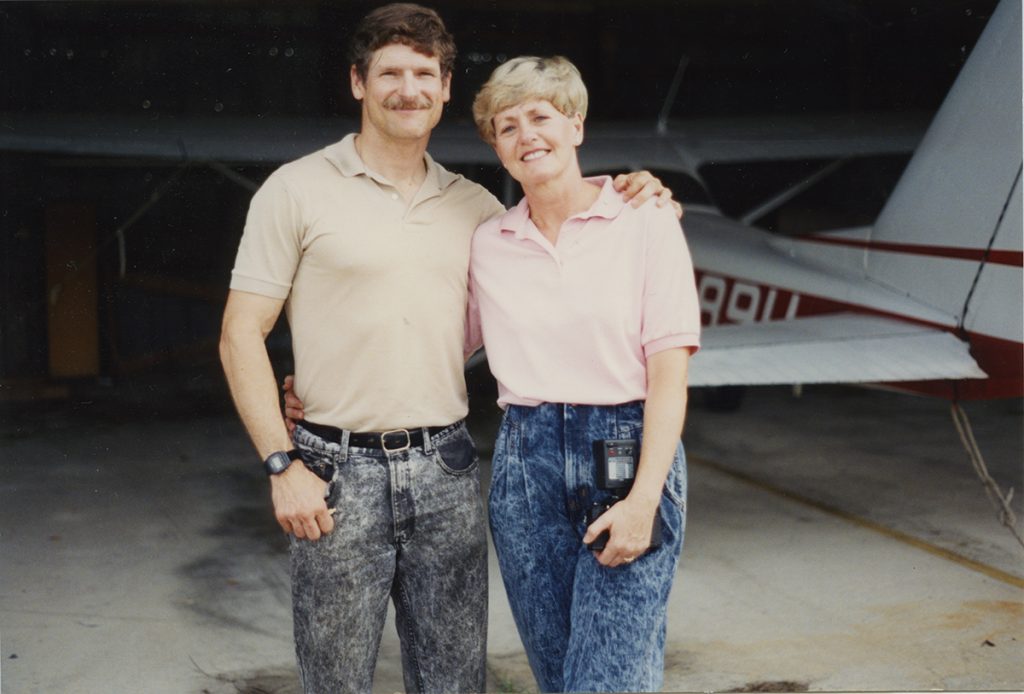
During 1978, two divers reached 325 ft/99 m in a Missouri cave. They were experimenting with trimix (helium/oxygen/ nitrogen). Although only 50 percent of their mixture was helium, both became hypothermic and had great difficulty finishing their required decompression. Sheck followed these stories carefully, remaining unimpressed with helium’s potential. He had gone deeper in caves using compressed air. Why should he be concerned with helium?
American cave diver, Dale Sweet, finally made a successful breakthrough with mixed gasses in 1980. Using heliox, he bottomed out the west Florida sink Diepolder #2 at 360 ft/110 m. Dale’s dive had broken Sheck’s deep cave dive record by 20 feet/6 meters. His achievement immediately got Sheck’s attention. Six months later Sheck made the same dive using air. Matter settled!
The big bombshell came from across the Atlantic in 1981. Europe’s best underwater cave explorer, Germany’s Jochen Hasenmayer, descended into the French Vaucluse to 476 ft/145 m. Everyone was stunned. Not only had he shattered Sheck’s cave record by over 100 ft/30 m, but he had also set a new world’s record for a surface-to-surface dive on scuba. Jochen was breathing heliox.
Sheck was busy setting records of his own when word of Jochen’s extraordinary feat reached Florida. The team of Sheck, Clark Pitcairn, and Mary Ellen Eckhoff were making final preparations for a big push into the Big Dismal cave system. In June, the trio penetrated the underwater cavern 5,847 ft/1782 m. A month later, Sheck, Clark, and Bill Main made an incredible seven-stage-bottle foray into Manatee Springs. The effort produced, and remains today, the world record for swimming cave penetration of 7,665 ft/2336 m.
When Sheck finally stopped long enough to contemplate Jochen’s record, he still remained skeptical about the use of helium in cave exploration. “Both Jochen and Dale made impressive dives, but I felt that they were riding on luck. I wouldn’t give either of them odds to safely repeat the dives.”
Two years later, in 1983, Jochen made another deep dive. The result—an astounding 656 ft/200 m plunge. Again, he was using heliox. With this one dive, the “barrier” that had been firmly in place for over a dozen years was swept away. Rules had been changed. A new era had begun. Matter settled!
The use of the Navy’s decompression tables to prevent decompression sickness (bends) has been standard procedure for scuba divers since the sport began. These tables, however, are not applicable when breathing mixtures are changed from air (21% oxygen/79% nitrogen). With the advent of saturation diving from deepwater habitats in the 1960s, the perplexing search for reliable mixed gas tables for surface-to-surface diving came to a standstill.
Around this time cave divers began to challenge deeper caves. Their ventures had many obstacles, the most pressing was safe decompression.
The 1987 Wakulla Spring Project, headed by Dr. Bill Stone, combined the latest in diving technology to explore one of Florida’s largest and deepest cave systems. The twelve project divers, including Sheck, penetrated over 1219 m/4,000 ft into the passages at depths to 300 ft/91 m using mixed gas, a historic milestone in cave exploration.
During the intensive diving, not one explorer had problems with the bends. The tables used at Wakulla came from a new source—DCAP (Decompression Computation and Analysis Program), a creative computer program operated by Bill Hamilton and Dave Kenyon from Tarrytown, New York. Sheck was impressed; this was the break he had been waiting for to get deeper into Mante.
After leaving Suwannee High School, Sheck drove to his home located a few miles outside Live Oak. He had purchased this particular piece of land a few years back because less than 200 ft/61 m behind his backdoor, a sinkhole opened into the world’s largest aquifer system. I was sitting on the front porch of his doublewide, surrounded by cameras and scuba equipment, when the van pulled through the gate. A loud greeting preceded Sheck out of the van. “Tepeizcuinte, Que Pasa?”
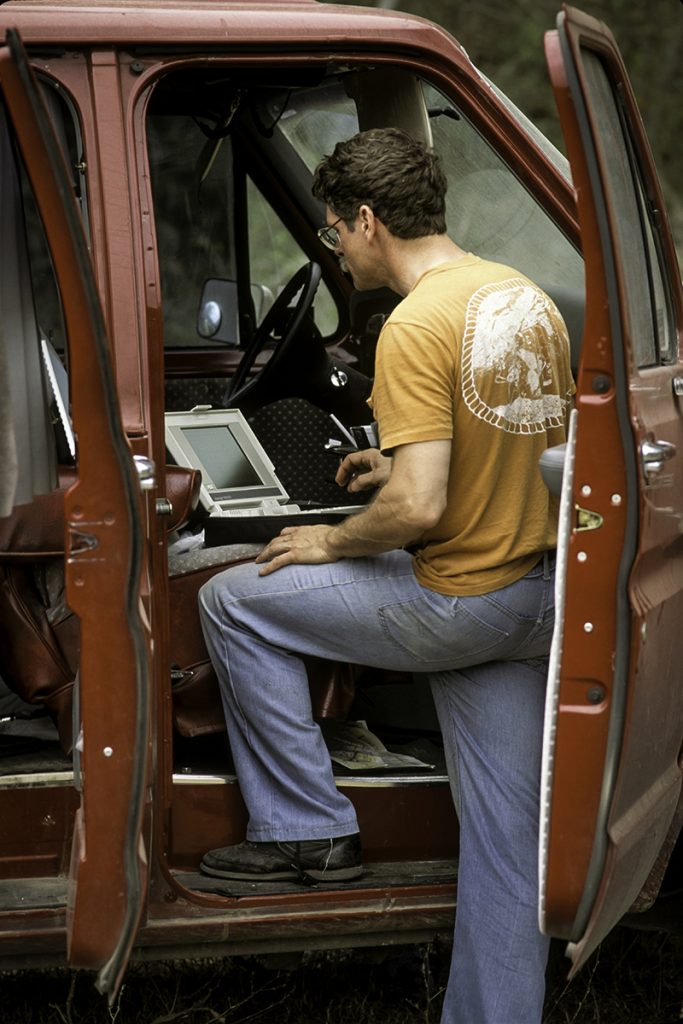
He tagged me with this outlandish nickname during a reconnaissance trip we made to the Yucatan coastal caves in the ’70s. Short on cash and civilization, we found ourselves eating from a limited wildlife menu at a cheap Mayan restaurant located just off the Xcaret road. The bill of fare consisted of lobster, grouper, venison, and tepezcuintle.
“Que es tepezcuintle?” Sheck asked the young boy waiting our table.
From what could be deciphered from his mumbled answer, we gathered that it was a small animal hunted in the jungle. In a moment of daring, we both ordered tepezcuintle and Pepsi. Although the exotic entree had been disguised by preparation and cooking, our servings suspiciously resembled skinned wharf rat done to perfection and served in a green mole sauce, except that on the ends of their small, muscular legs were sets of tiny hoofs.
Smiling, Sheck came up to the porch and we shook hands. I followed him into his darkened living room where I almost tripped over a five-foot Aquazepp underwater propulsion scooter that dominated the center position in a room filled with charts, files, books, and an assortment of unmarried-man clutter.
In the kitchen, he shoved papers aside, sat down, and began to intently study a neatly spaced, three column list he had taken from his pocket. Each item represented a vital link necessary for the completion of the most daring and logistically complicated scuba dive ever attempted. After nine months’ planning, nothing was going to be forgotten in a last-minute rush to leave town.
I left him at the table and began to load my gear between the stacks of tanks roped tightly together inside the van. Ten minutes later, Sheck emerged carrying a paper sack of groceries.
“About ready?”
“Sure,” I replied. Less than five minutes later we were heading west on 1-10. Our long drive to Mante would take us nearly 1,500 miles/2,414 kilometers—across the south eastern states, through Houston, down to the Rio Grande Valley, where we would cross the border at Brownsville—and then 300 miles/483 kilometers miles on into Mexico.
I had not seen much of Sheck for the last few years. A cave diving photography project in Yucatan had occupied my last two summers, while Sheck had been busily involved with his deep cave diving and whitewater kayaking. During the Wakulla Project I spoke to him briefly; the next month we shot some cave diving pictures for his autobiography, to be published next year. I had heard about his big dives at Mante, but knew few details.
Sheck called to ask if I would go with him to Mexico only three weeks before we were scheduled to leave. I said yes thinking that the expedition south would involve a substantial support group. It wasn’t until the week we left that I realized it was just the two of us driving down. We were to meet Mexican cave divers Sergio Zambrano and Angel Soto at Mante. They were driving north from Mexico City to make the rendezvous. Both were exceptional cave divers, but I realized that neither had the experience to help Sheck if an emergency occurred.
It was only at this point that I started to comprehend the intricate web of problems that would face Sheck. There was no support for such a dive— absolutely none. Not the Navy, not commercial diving companies, not even the cave diving elite could be of the least assistance where he was going. Sheck would be a one-man show heading straight for no-man’s-land where submersibles and diving bells couldn’t go. If something were to happen, the show would be over—no rescue, not even a body recovery would be possible.
As we drove past Tallahassee and headed toward Pensacola, Sheck began to tell me about the dive. “After Jochen Hasenmayer’s dive to 656 ft/200 m, I knew that helium was obviously the way to go. In late 1986, I made two practice dives on helium in Florida. The first was to 40 m/130 ft, the second was a 260-footer/79 m. Last April, Mary Ellen (Eckhoff) and I left for Mexico. After eight years I was more than ready to extend the line deeper into the Mante system.
“Two days before the dive we staged five tanks in the cave. I wasn’t sure how deep I would go. I had decompression tables for 400 ft/122m and extrapolations for even greater depths. My depth gauge was good to 500 ft/152 m. As it turned out, everything went well and I tied off when the gauge read 500 ft/152m. Since they are calibrated for denser sea water, that meant 515 ft/157m at Mante and my feet were five feet deeper, so 520 ft/158m. Over seven hours and 26 decompression stops later I surfaced. Nothing to it,” he laughed.
“What made you decide to go back after the 520 ft/158m dive? Was it Hasenmyer’s record?”
“Yeah, it was the record, but besides that, Mante was still dropping and I wanted to be the one to bottom it out.
“Mary Ellen and I went back in June, just two months later. I had made a few alterations in my decompression to help alleviate the oxygen toxicity symptoms—muscular twitching in my face and legs and slight tunnel vision—I experienced during my previous dive. This time I used less oxygen and two additional shallow water decom stops were added.
“It took me 24 minutes to drop 660 ft/201m. Everything worked well, but it cost me eleven and one half hours of decompression time. Over twelve hours is too long to remain underwater. I became extremely uncomfortable—cold, weak, and hypoglycemic from the pre-dive liquid diet. My exposed hands and face became wrinkled, raw, and began to flake. At the time I felt that I could have dived deeper, but I knew that I had reached my decompression limits.”
“You said you reached 660 ft/201m. It sounds like you went just deep enough to beat Hasenmayer’s record.”
“No, not at all,” Sheck replied. “The best way to end up dead on a deep dive is to go after a set number. First, you have to understand that I didn’t know how deep I was after I left my depth gauges at 515 ft/157m. To figure my depth, I connected a premeasured line to my previous line. At the deepest point I tied off and cut the strand. After surfacing, it was a simple matter to calculate my depth from the remaining length. When I decided to turn around I had no idea if I was above or below Hasenmayer’s depth. As it turned out, I was so close to his mark that I didn’t claim the record.”
“So now you’re headed back,” I asked.
“Yea, so now I’m headed back,” he repeated.
With that, we silently settled into the ride. Sheck slid a cassette into the deck and soon we were absorbed in the sounds of his beloved Beethoven. We were 350 mi/563 km into the trip, just west of Mobile, when we switched places. I climbed behind the wheel and Sheck stretched out in the reclining passenger seat. A light rain began to fall. I glanced over at Sheck. He was resting with his hands behind his head. Since our earlier conversation we hadn’t talked about the dive, but I couldn’t get it out of my mind. Sheck would soon be asleep, this would be the last chance until morning to ask questions.
“How deep do you think you will be able to go on this trip?” I asked suddenly. Sheck didn’t answer for a while. Then just as abruptly as I had asked the question, he answered.
“At least 700 ft/213m, maybe more.” Again silence. I waited but he didn’t continue.
I tried again. “What about decompression?”
“I’m using new tables,” he replied. It was obvious that he would rather be with his own thoughts than in conversation, but I chose to persist.
“Whose tables are they?” With this Sheck relented and sat up, adjusting the seat to support his back.
“Bill Hamilton’s, the fellow from New York who did all the tables for the Wakulla Project.”
“Have they ever been tested as deep as you’re planning to go?”
“Of course not. Who would test them?” he answered tersely.
“Hasenmayer,” I retorted. Sheck broke into laughter. He was ready to talk.
“I was maxed-out on decompression during the 600 ft/201m dive. When I finally got out of the water I was wasted. I knew then that I would have to come up with a shorter schedule before I went deeper; and besides, I was losing confidence in the tables I used for my four previous dives. They were based on purloined commercial tables that I extrapolated to the point that I was concerned about their validity.
“Hamilton’s DCAP program was not only more liberal than the tables I had been using, but it allowed me to custom-tailor my gas blend. The few cave divers who are now using mixed gases are abandoning nitrogen altogether. My body seems to have a high nitrogen tolerance, so I choose to use tri-mix during the deepest part of my dive, hoping that this will help me avoid helium’s high pressure nervous system syndrome and hypothermia.”
“Using the computerized tables for this dive will require that I stage sixteen bottles and carry four tanks. Eleven different blends will be used. I will make 52 decompression stops, starting at 520 ft/158m and ending with a half hour at the surface breathing oxygen. How long the stops take will depend on the descent time, maximum depth, and how quickly I can get up from the deep water. The last variables can’t be plugged in until I actually make the dive.”
I glanced over at Sheck. He was again lost in thought, staring blankly into the night. It had been fascinating listening to him discuss the facts and figures of the dive, but what I really wanted to hear about were the things that go on inside his head when he is buried under several hundred feet of water, inside a rock crevice, on the very edge of life, and still going down.
“How are you going to decide when you have gone deep enough?” I asked.
“Fear.” Sheck answered immediately as if he had been patiently waiting for such a question.
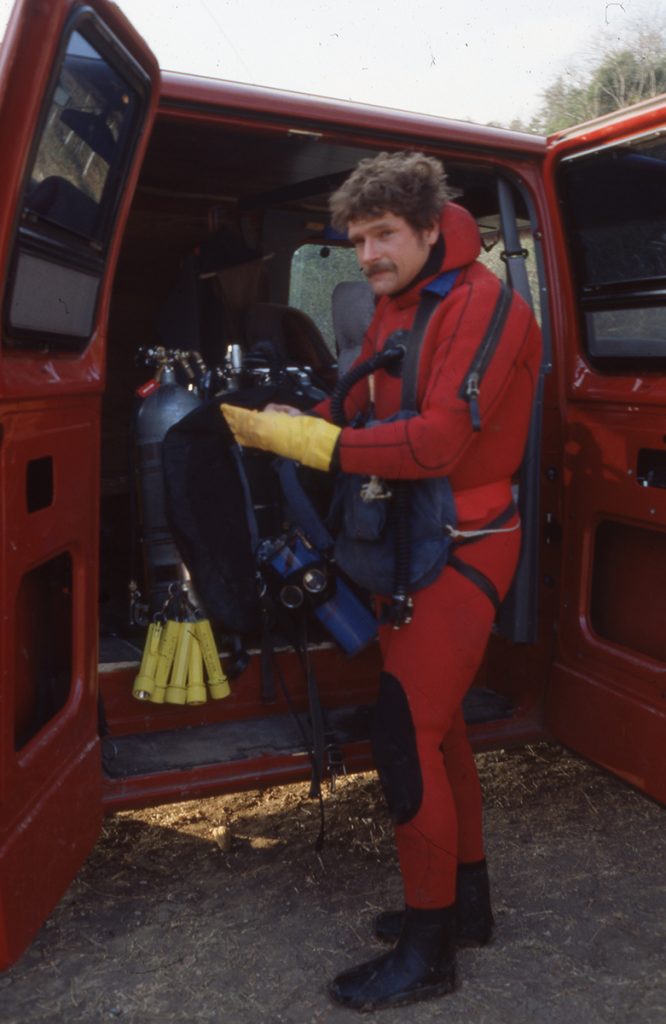
“It’s a mind game. The cave and the odds are out to get me, and it is obvious that they will catch up with me sometime. That I am alive today is a miracle. To extend my winning streak I must spend hundreds of hours thinking of every possible thing that can go wrong. I do what I can to prevent problems during my dive preparations. I mix my own gases, I check every piece of equipment over and over, and I memorize each aspect of the dive plan. The dive itself is like hunting a tiger in a thicket. Fear keeps me alert. I am constantly attuned to every feeling in my body, every function of my equipment, and every happening in the surroundings. Off guard for a minute and the tiger is on my back”
I‘ve learned to handle the fear by what I call controlled paranoia—a combination of meditation and experience. The meditation clears and settles my mind, allowing me to stay at a high state of alertness and continually aware of my body’s reaction to the stress. My experience has taught me how vulnerable I am.”
“During my 23 years cave diving, I’ve survived every life-threatening situation: bends, panicked buddy, being lost, silt-outs, light failures, out of air, line entanglement, trapped in restrictions, on and on. When something goes wrong, I must immediately rein in the fear and let experience take over. Problems can occur, but an error in judgement is deadly.”
“From the dive’s start, the idea is to get down as fast as possible without plummeting out of control. I use gravity and pull on the wall to keep from using my legs, which will increase my exertion. While dropping in the deepest part of the shaft, I’m in a high-risk zone. At such depths, each breath causes the pressure gauge needle to drop unbelievably. Like a pilot constantly picking out alternate landing sites for emergencies, I’m always looking for a projection to tie off. If anything goes wrong, my experience takes over. The problem must be solved on the first attempt, or I immediately abort the dive. If the dive goes as planned, the turnaround point will be dictated by my down time, the amount of gas expended, and an indefinable coalition of sensory perceptions that tells me to get the hell out.”
After finishing the statement, Sheck then wished me good night and crawled across equipment to the back of the van where he had constructed a platform bed over the tank storage. To save time, we had planned to drive straight through to Mexico. I was to drive the night shift so that Sheck wouldn’t have to alter his regular sleeping habits before the dive. A mellow, sensuous sax from an all-night New Orleans station kept me company through Louisiana and into Texas. We streaked through Houston at 4:00 a.m. and were ready to head south toward the border when he crawled back to the front.
“How about breakfast, amigo, or do you want to drive a bit further?” he joked. We pulled into the first diner I saw. My body was still on autopilot and buzzing from fatigue after the eight-hour ordeal. Sheck was making an issue of how well he had slept as we walked into the restaurant lobby, where a set of brightly lit arcade games glittered against the wall.
“Hey, amigo, just the thing for you.” He stepped over to a machine and dropped a quarter in the slot. An animated race car leaped into action, careening from side to side at a dizzying pace down an endless highway. As I stumbled into the dining room, heading for the first vacant booth, I could still hear echoes of Sheck’s laughter coming from the lobby.
We crossed the border at noon. It was always exciting being in Mexico, a country I learned to associate with great pleasure. During my dozens of trips there I had acquired a penchant for the land and people, but not for Customs. There we were, packed to the pavement with tons of elaborate underwater equipment, trying our best to act nonchalant like ordinary tourists out for a weekend’s fun. The first official who looked in the van called another, who called another, who called another. In the meantime, Sheck was inside efficiently going from desk to desk getting our papers approved. By the time an inspector came inside to report the strange load, Sheck had all the documents signed and stamped. A mini-summit was held in the foyer. We suddenly spoke no Spanish; just kept repeating “scuba holiday” whenever one of the inspectors glanced our way. Twenty dollars later we were heading out of Matamoros.
The highway’s first 150 mi/241km miles passed through sparse, flat agricultural land similar to southern Texas. Then, in the distance, we saw the mountains begin to rise. This was the emergence of the wild terrain that inspired B. Traven’s classic, Treasure of the Sierra Madres; a bold frontier for hardy spirits where fortune and tragedy co-exist only a heartbeat apart.
We spent the night in Victoria, choosing to wait for the freshness of morning before tackling the 100 mi/161km miles of twisting mountain roads that wind their way to Ciudad Mante.
When we woke, the morning sun was still red on the mountains and the air was cool. We set out early so that we would be unhurried during the difficult drive. It was Easter Sunday. Mexico was dressed in its finest. All along the roadway well-groomed families followed the sounds of church bells to early services.
The night’s rest readied us for the mountain road, but as expected, progress was slow. It took three hours to reach Ciudad Mante. Sheck drove straight through the town without stopping. At the southern glorieta, we veered off onto a narrow road that led toward a distant mountain range. It was the end of the dry season and Sheck was anxious to learn if the lack of rain tempered the spring’s flow. The volume of water that surged up the crevice was a critical factor in how deep he would be able to dive.
As we approached, the dark mountain bluff began to show detail. Large runs of limestone, separated by dense foliage, shot straight up from the plain. The closer we drove the higher it grew, until the crest could no longer be seen through the windshield. We paralleled the cliff for a quarter mile before arriving at the spring.
While walking down to the water, we saw two dry-suited divers with fins in hand coming up the embankment. Sheck immediately recognized the men. They were Sergio and Angel returning from their first dive into Mante. Warm greetings were exchanged. While the two cave divers removed their cumbersome gear, Sheck led me to where I could get a view of the spring cave.
There it was, exactly 1,464 miles/2,356km from Sheck’s front door; a cave entrance right out of a Speilberg movie. Looking down from the cliff, we watched the water pour from the mountain. It rushed from the bottom half of the cave entrance into a blue spring pool 50 yds/46m wide. Although it was only midmorning, several bathers already sat cooling themselves on the basin’s rocks.
We left the spring for town, following Sergio and Angel’s jeep. After checking into a hotel, we ate lunch together. That morning they dived the cave to 180 ft/55 m. The visibility was 50 ft/15 m and the flow moderate. Conditions were good for Sheck’s dive.
Sergio and Angel are expedition men in the purest sense—a pair that goes to exotic places to do extraordinary things. Himalayas, Peru, sky-diving, rock climbing, and for the past five years, cave diving. They do such things for no other reason than the spirit moves them. During the difficult process of setting up and breaking down his dive, Sheck could have no better help. Both men worked diligently helping to stage the sixteen tanks in the cave and were always available to do what needed to be done. One of their strengths is knowledge. Immediately they questioned Sheck about how he was going to put together his dive.
After lunch, Sheck made the decision to move the dive up a day. We had arrived at Mante ahead of schedule, the weather was splendid, and he was anxious to get started. The change of plans meant that he had to make a difficult 330 ft/101m dive that evening to stage the deepest tank.
When we returned to the spring at 4:00 p.m., the basin area was swarming with holiday bathers. During the two hours it took to prepare for the dive Sheck was surrounded by onlookers who asked a ceaseless stream of simple questions. Hot, annoyed, and losing concentration, he finally asked the crowd to leave him to his job. Courteously, they all backed up a few paces, and once again commenced with their inquisition. After he was finally outfitted and heading to the water, his faithful entourage followed closely at his heels. A few even splashed happily after him as he pulled his heavily equipped body through the current and disappeared inside the cave.

It was dark and the crowd long since gone when I saw his light beam cut through the pool. In the time he was down, I made a dive into the cave, explored the cliff above the basin, read several chapters in War and Peace, listened to somba tapes, and took a nap.
What a trial of boredom Sheck must have experienced during the same period while hanging from the rocks, waiting for the nitrogen to seep from his tissue. That evening’s decompression was only a quarter of what he would have to endure in two days. If a problem developed during the deep dive, forcing him up early, he was certain to sustain a serious bends hit. The shortest route for treatment to relieve his agony would be a 90 mile/145km mile drive to Tampico, a low altitude flight to the Harlingen, Texas, airport, and then an air ambulance to Methodist Hospital in San Antonio—the closest chamber.
The next day was long and busy. Fifteen additional tanks were tied off. Sergio and Angel secured stage bottles twenty feet apart from 49 m/160 ft to 80 ft/24m, and at 10 ft/3 m intervals from 70 ft/21 m to 30 ft/9m. Sheck made another deep dive, leaving two cylinders at 270 ft/82 m, one at 240 ft/73m and another at 210 ft/64m. This time I followed behind taking pictures. At 100 ft/30 m I stopped in the center of the narrow passage and watched Sheck, silhouetted by his powerful light, go down beneath me until his beam evaporated in the darkness.
That night at eleven, when I turned out my reading light, Sheck was still knotting line and double-checking charts. In the morning, when I awoke, his bed was empty. I found him in the van cleaning the second stages on his regulators. He was so intent in his effort that I said nothing and went back inside to dress. A moment later he came in. It was easy to tell by his actions that the paranoia was beginning to set in. To and fro, from box to bag he went with long quick steps.
“Good morning,” I said.
He stopped and glanced around to where I was sitting on the bed.
“Can I help you with anything?” I asked.
“Good morning, yeah, sure, here.” He handed me a paring knife and a whetstone he had just taken from a gear bag. It was the knife from his wrist scabbard that would be used to cut the line at the dive’s deepest point.
“Moving the dive up a day has set me behind,” he stated. “Really shouldn’t be diving today. It’s already getting late, almost seven now.”
“Just wait until tomorrow,” I suggested.
“Maybe. We’ll see—I’m close now.” He left the knife and stone in my hand and bounded across the room where he began to copy a duplicate set of decompression times on plastic tags.
“Hey, another day doesn’t matter. Why not wait?” I asked.
He glanced in my direction. “To tell the truth, I don’t want to think about it another day. We should be out of here in half an hour.”
We arrived at the spring just before eight. Three sentences weren’t passed between us on the ride out. His thoughts were lost in the dive. Not one of the dozens of important details could be forgotten, or his attempt would end in failure. Like a team whose pitcher is going into the ninth inning with a no-hitter, Sergio, Angel, and I ignored Sheck. We sat twenty yards away, on the tailgate of their jeep, watching him ready his final equipment.
Sitting there, my thoughts went back to a conversation I had with friends from Miami just before I left for Mexico. We were discussing Sheck’s proposed dive.
One of the questions they asked was, “How are you going to feel when Sheck actually starts down?”
Then I was rather flippant with my answer, but now, close to the dive time and more educated about the difficulties involved, I began to rethink my position. Those who knew about decompression with mixed gases, both in the Navy and commercial diving business, gave Sheck no better than a 50/50 chance of surviving the attempt. Decompression was only one problem he had to overcome; there was also helium’s high pressure nervous system syndrome, hypothermia, oxygen poisoning, pulmonary edema, equipment failure, and, because he was using nitrogen in the deep mixture, narcosis. Sheck was learning how to put the entire package together and now was the time to see if it worked.
He was not a daredevil; he was an explorer who spent twenty years preparing himself mentally and physically for underwater challenges. In the years I had known him, I had acquired an almost mythical confidence in his ability to accomplish amazing dives. He was simply the best and most experienced diver in the world. If it were physically possible to pull off a 700 ft/213m plus dive, Sheck was the one who could do it. As I watched him make his final preparations, the question for me was not whether he would survive the dive, but how deep would he go?
At 10:45 a.m. when he finally entered the water, perspiration was beginning to soak the heavy wool overalls he wore inside the sealed dry suit. His face was scarlet. On his back were two 100-cubic-foot/11 ltr. cylinders containing trimix. Slung under his chest and extending below his waist were two additional tanks—one filled with air to begin the dive, in the other, trimix.
With a nod he submerged.
I watched from a narrow ledge above the cave as he pulled himself toward the entrance. Once he was inside I walked a distance down the Rio Mante and sat alone in the shade of a palm thicket. I leaned back and began to imagine Sheck’s present situation.
Eight minutes pass since he enters the cave. He is 100 ft/30m inside the dry chamber kneeling on a shallow rock shelf meditating. The brief rest allows his pulse to settle and his mind to clear the predive pressure. Periodically, he plunges his maskless face into the cool water.
Two minutes later he turns on his four backup lights and the bright primary unit built specially for the 700 ft/213m dive by English Engineering. With the regulator to the air tank gripped between his teeth, he pushes his weight off the ledge, gains control of his awkwardly ballasted body, and swims 50 ft/15 m underwater to the lip of the drop-off. He checks the exact time and enters the figures on his slate, purges the last bit of air from his buoyancy vest, and begins to descend into the crevice.
Against the strong flow, he pulls himself down, arm over arm, following the line on the south wall. Three minutes into the dive, at 58 m/190 ft, he skirts left over a rock promontory and then once again down. Here the passage widens to 15 ft/5m and the walls are much smoother; he is forced to kick to keep his pace. His pulse quickens slightly with the added exertion and he slows his effort as he passes the stage bottles at 210 ft/64m, and then 240 ft/73m.
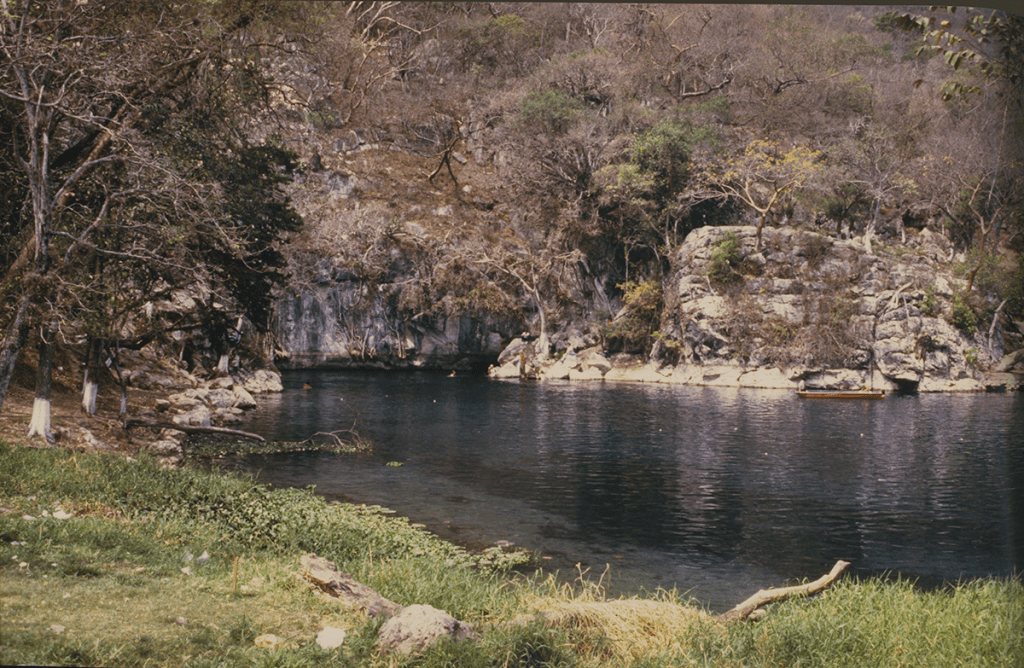
Six minutes into the dive, 270 ft/82m below the surface, he makes his first brief stop to exchange his air tank for the waiting cylinder of trimix. At the ten-minute mark he knows he is 400 ft/122m down when he spots the blue garter left by Mary Ellen last June. The crevice walls are now separated by 30 ft/9m of water—their widest point. His descent is in control.
At 520 ft/158m he briefly pauses to attach his backup watch and two depth gauges to the line and begins to breathe the trimix on his back. The attached pressure gauge and his watch are now the only instruments to monitor his situation. Their readings are vital.
At 660 ft/201m below the mountain he arrives at the line’s end. It has been seventeen minutes since he started his descent. He attaches the line from his reel and begins his drop into depths never before reached by free-swimming man.
“As I entered the unexplored cave zone, I was concerned about my slower-than-expected rate of descent. I forced myself not to pick up the pace. Instead of continuing its vertical drop, the crevice began to narrow and run at a 60-degree angle. Flashes of narcosis were becoming more prominent. I glanced at my pressure gauge. I had a problem—the reading hadn’t changed since my last check. I banged the unit on my tank. The needle jumped several hundred pounds lower. Pressure had forced the lens against the needle, but had it stuck again? I had no way of knowing. A projection to tie off was just below. I passed it and dropped deeper. The tunnel began to flatten out, falling at a 45-degree angle. I looked at the pressure gauge; it showed a third of the gas was gone. Was the reading correct? I had been down just over 22 minutes. It was time to get out.
“My light beam fell on an excellent tie-off 20 or 30 ft/6 or 9m down. I took a breath and moved toward the projection, when suddenly a jolting concussion almost knocked me unconscious. I looked behind for a ruptured valve or hose. There was no leak. Something imploded from the pressure, but what? I drew another breath and kicked the last 8 ft/2m to the tie-off. Quickly, I threw two half hitches around the rock, reeled in the loose line and made the cut. My down time was 24 minutes ten seconds.
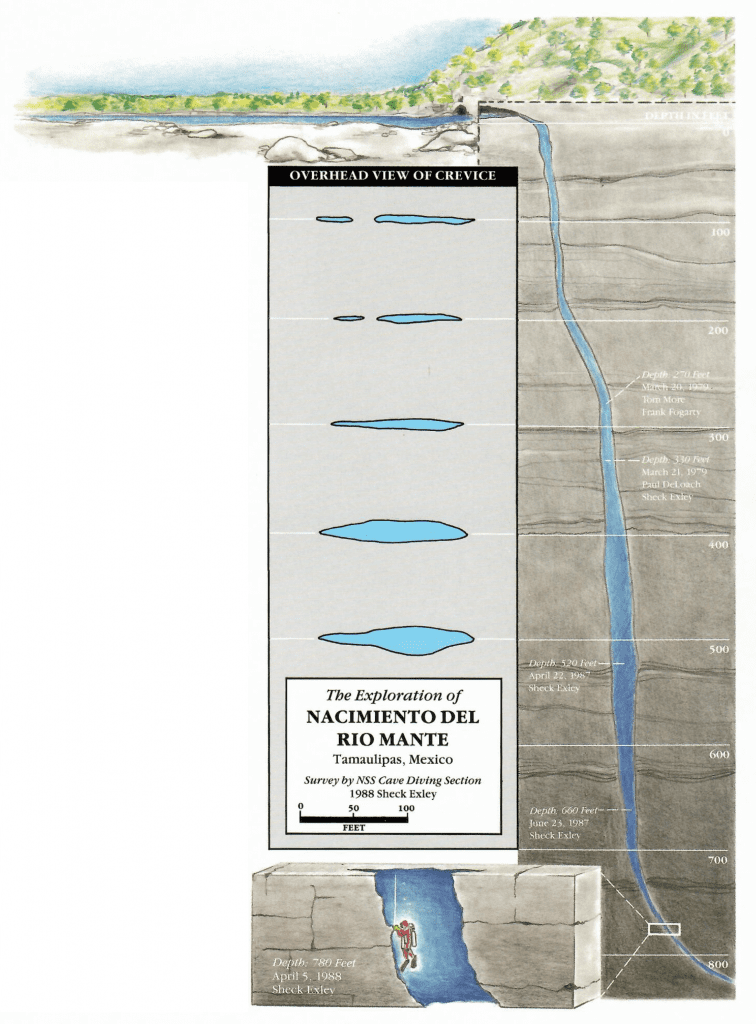
“I wanted to move fast from the deep water, 120 ft/37m per minute if possible. The current that I had battled during my descent helped to lift me up the incline. I drew a breath and felt a slight hesitation from my regulator. The next breath came harder. Was I out of air? Again, I hit the gauge on my tank but this time the reading didn’t change. If I was forced to use the gas in my belly tank, I would miss all my decompression to 330 ft/101m where my first stage bottle was tied off. I switched over to my backup regulator and with relief drew a full breath.
“At 520 ft/159m I untied the gauges and started my decompression. It was strange to be decompressing at such a depth, knowing that only one person had ever gone deeper. I remained for a minute and then began to ascend at the rate of 10 ft/3m per minute until I reached 340 ft/104m. When I saw my first stage bottle and knew that I had spare gas around me, I finally began to relax. My stress was gone, but the long decompression stops were only beginning.
“Now, with extra time, I began to search for the cause of the deafening implosion. The source was the large plexiglas battery housing for my primary light. The pressure had been so great that the .75 in/2 cm lid was forced into the casing, crushing the battery pack. Amazingly, the light still functioned.
“Next, I counted the knots on the line remaining in the reel. I factored in the angle of the cave’s lower reaches and estimated that I dived 780 ft/238m—a world record depth for a surface-to-surface dive.”
Three and a half hours after we last saw Sheck, Sergio and Angel made a dive to locate his position and offer assistance if needed. They found him at 100 ft/30mt, suspended behind a cluster of twelve empty scuba tanks. Sergio handed him a slate with questions prewritten in English. Sheck wrote the answers in Spanish.
At 9:30 p.m. he finally arrived back at the surface. Sergio, Angel, and I were waiting in the light of a butane lamp. He had been below water for ten hours and 43 minutes, but his decompression dues were still unpaid. For 30 additional minutes, he remained kneeling in the basin breathing pure oxygen.
When he emerged from the water, he resembled an old man. His face and hands were severely wrinkled and his walk faulty. Three times, on his way to the van, he stopped to calm his racing pulse. Later, while struggling to free himself from the dry suit, I saw weariness set deep in Sheck’s face like I had never seen in another man. What came to mind was Hemingway’s description in The Old Man and the Sea of Santiago’s utter exhaustion after his battle with the sharks.
We were up early the next morning. Sheck was surprisingly strong. He did most of the work repacking the van and drove 300 miles/483 km of Mexican highway before the day was over. At the beginning of our return trip, just after leaving Ciudad Mante, I asked him a question that had haunted me since the dive.
“Will you ever do it again?”
From behind the wheel he cocked his head, gave a sly half smile, and answered. “I don’t know.”
🎶 MUSICAL INTERLUDE: At a time when the rules changed on every dive, every meter of line laid was in a new unseen and unventured territory, and equipment innovations although revolutionary were often fraught with risk; what drove cave pioneer Sheck Exley to go where no one else had gone before? One can only assume it was something not rooted in logic but instead living and beating in his heart or maybe his Red Right Hand. Apart from having an apt name, Nick Cave’s 90’s epic Southern gothic anthem sets a moody underground tone for this issue of InDepth, as it explores the lure of extreme cave diving—Victoria Brown
DIVE DEEPER
InDEPTH: NSS-CDS Guide May Have Found Exley’s “Lost” Tunnel At Madison Blue
InDEPTH: A Page Out of History: Sheck Exley’s 1989 Mante Table (867 ft/265m)
aquaCORPS interview with Sheck from aquaCORPS #4 MIX (JAN 1992): Exley On Mix You can find the word cloud for Sheck’s interview here.
Sheck Exley’s story about machismo and the tragic death of his brother for aquaCORPS’ technicalDiver 3.2 (OCT 1992): It’s Your Call
Tribute to Sheck following his fatal dive from aquaCORPS #8 HARD (SEP 1994): Eagles Fly Alone by Ned DeLoach
Accident Analysis Report from aquaCORPS #9 Wreckers (JAN95): What happened to Sheck Exley? by Bill Hamilton, Ann Kristovich And Jim Bowden
The Story of Sheck Exley, Jim Bowden and Ann Kristovich and the exploration of Zacatón from aquaCORPS #11 Underground XPLORERS (AUG95): Dr. Ann and the Zacatón Explorers by Jim Kelly
Wired Magazine (1995): Under Pressure by Jerry Shine. Scuba had finally come full circle: from the first explorers who strapped on archaic tanks back in the 1950s to technical divers who now strapped on underwater computers and dive to depths so great the pressure could crush a car faster than a five-car pileup. [This story details Sheck and Jim Bowden’s last dive at Zacatón and the technical diving scene in 1990s.—Ed.]
Sports Illustrated (1994): DEEP, DARK AND DEADLY: THE PERILS OF CAVE DIVING DIDN’T SPARE EVEN THE SPORT’S GREATEST STAR by Michael Ray Taylor
This film, by Jim Thomas is a tribute to legendary cave explorer Sheck Exley prepared for the 50th anniversary of his story “Lost in the Slough,” one of Sheck’s most miraculous dives. Through re-creation and investigation, we rolled back the mysteries and uncovered details missing for 50 years that put this story on par with any classical tale of yore.

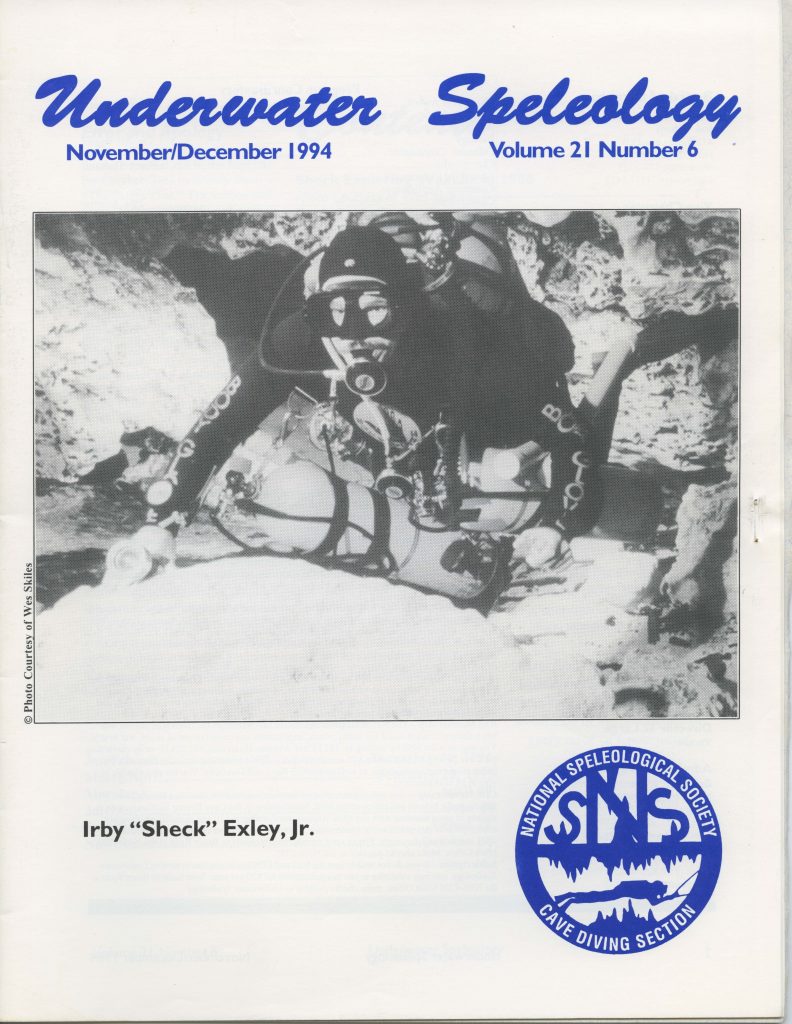
In the fall of 1994, approximately six months after Sheck’s passing, the NSS-CDS produced a special issue of its membership magazine Underwater Speleology Volume 21 Number 6 featuring the writing Sheck Exley. You can save a copy to your device from the link above. Special thanks to the NSS-CDS, Mary Ellen Eckhoff and documentary film maker Brian Udoff for making this possible.
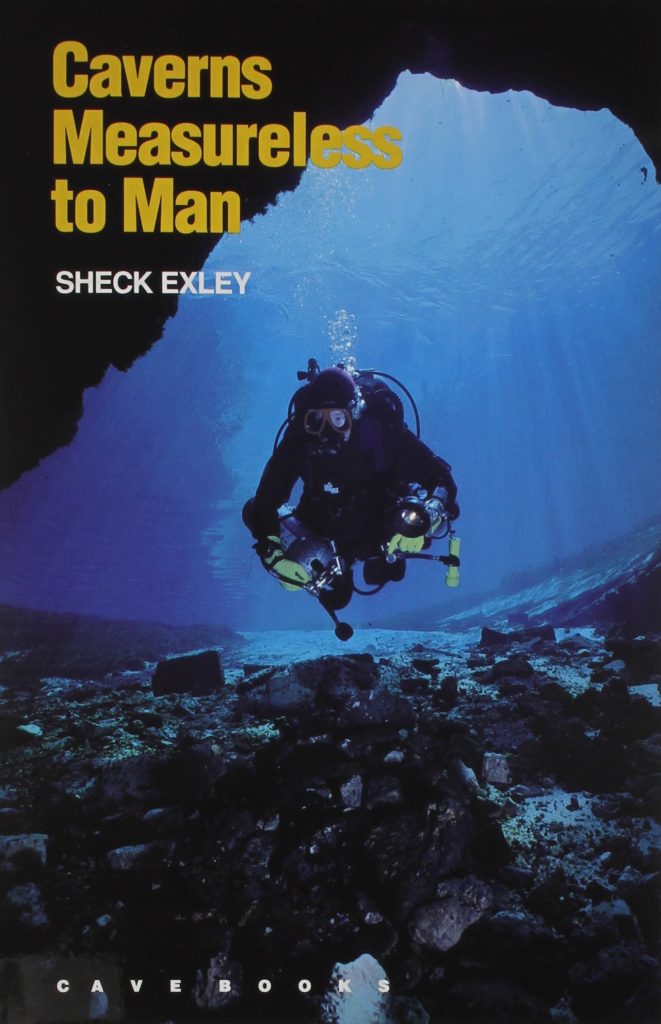
You can purchase copies Sheck’s books; Basic Cave Diving: A Blueprint for Survival, Caverns Measureless To Man, and The Taming of the Slough-History of Peacock Springs, here at the NSS-CDS online bookstore.
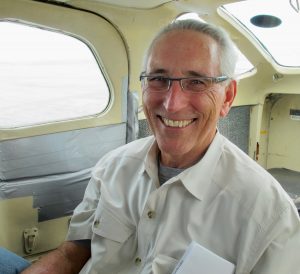
After college Ned DeLoach moved from his childhood home in West Texas to Florida to do what he loves best—dive. In 1971 he completed his first diving guide to the state, Diving Guide to Underwater Florida, that was in publication for 48 years. Through the 1970s and 80s, Ned was active in Florida’s cave diving community, helping Sheck Exley edit and photograph early cave diving education material. In the mid-80s he began working with Paul Humann as co-editors of Ocean Realm magazine. In 1989 the pair published Reef Fish Identification, Florida, Caribbean, Bahamas, which launched an extensive library of visual marine life field guides for tropical oceans around the world. In 1990, they also founded the Reef Environmental Education Foundation (REEF), whose volunteer survey divers have, over the past three decades, built the world’s largest reef fish sightings database, used widely by marine scientists, conservation, and wildlife management organizations around the world. In 2019, Ned and his wife Anna published a second edition of Reef Fish Behavior, first released in 1999. The couple has also written a column entitled “Encounters” for DAN’s Alert Diver magazine since 2010.


























